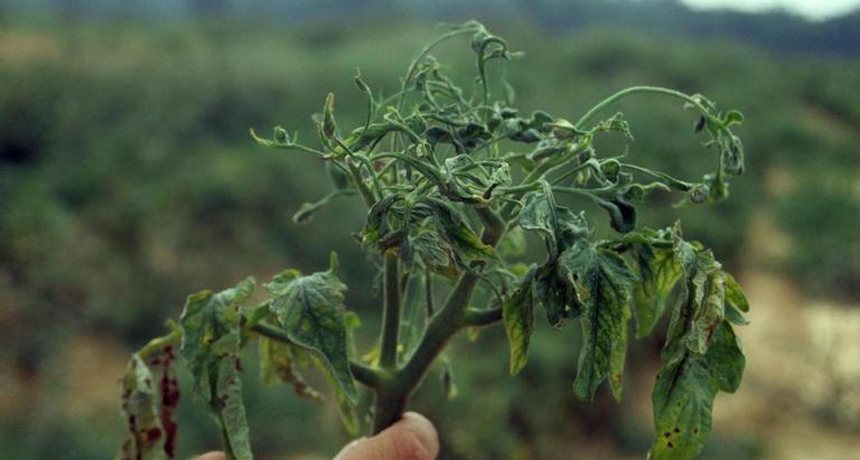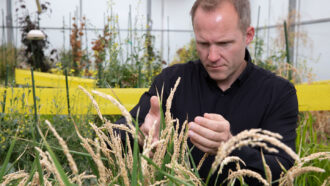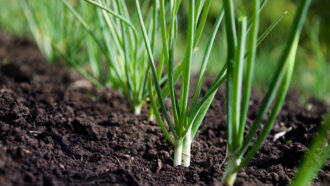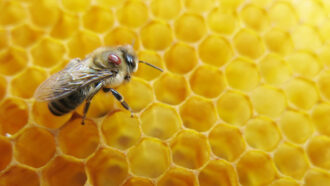Sneaky! Virus sickens plants, but helps them multiply
Infected tomato plants give off special perfume that lures bees

Greenery infected with cucumber mosaic virus, like this tomato plant, often are small and deformed. But the virus also helps the sick plants reproduce by making them more attractive to pollinators.
EDWARD SIKORA/AUBURN UNIVERSITY, BUGWOOD.ORG
One common virus takes a sneaky route to success. It doesn’t kill its leafy hosts. Instead, it makes infected plants smell more attractive to bees. That ensures this germ will have a new generation of the plants to host it in the future.
Pathogens are disease-causing germs and other organisms. The strategy used by the virus might keep plants from developing a way to fight off this pathogen.
“It looks like the pathogen is cheating a little bit. but in a way that helps its host,” says John Carr. He’s a biologist at the University of Cambridge in England. He and his colleagues shared their data August 11 in PLOS Pathogens.
Plants normally give off a mix of scented chemicals that can waft through the air. These signal a plant’s whereabouts to pollinators, predators and other plants. Carr and his team studied tomato plants infected with the cucumber mosaic virus. These plants gave off a different scent than non-infected plants. And bumblebees preferred the sick plants’ perfume.
So the infected plants will attract more bees, which will help pollinate their flowers. That’s the good news. What’s not good: Tomatoes infected with the virus become misshapen runts.
Tomato plants don’t always need insects to pollinate them; they can pollinate themselves. But when infected tomato plants tried to fertilize themselves, this way, they made fewer seeds than normal. If bumblebees helped out with the pollination, infected plants made a healthy number of seeds.
So while the virus sickens plants, it also ensures they can still make plenty of seeds. And this helps the virus, Carr points out. The sick plants that reproduce will pass on the genes that had left them vulnerable to the virus. So their offspring will be vulnerable too. Even if some plants are resistant to the virus, they won’t take over the population, since sick plants can still multiply well.
2b or not 2b
The team found another way that cucumber mosaic virus changes plant scents. It turns off their natural defenses against disease.
For a virus to reproduce, it inserts its genes into a host’s cells. It then hijacks those cells, forcing them to copy — reproduce — the germ. Normally, plants can tell when bits of foreign genetic material get inside them. Specialized plant enzymes should snap into action and chop up the foreign invaders. But the cucumber mosaic virus doesn’t let this happen, Carr and his colleagues found. The virus makes a protein called 2b. That protein then locks onto the plant enzymes. Now they can’t do their job.
The virus now can infect a plant more easily. It also changes the way the plant turns its own genes on and off. And that’s how the virus makes plants give off a different chemical mix. When the researchers infected plants with a virus lacking the 2b protein, those plants now made the same scent as a normal, healthy tomato plant again.
The link between the virus’s 2b protein and the plants’ chemical scents is a major finding, says Andrew Stephenson. He’s a biologist at Pennsylvania State University, in Philadelphia, and was not involved in the new work. Its discovery, he says, could help scientists better understand how viruses trick their hosts.
But it will take more research to prove that the virus’s role in increased pollination really helps a plant, Stephenson argues. Even though infected plants produce a healthy number of seeds, those seeds might be smaller than normal, he says. Or they might be less likely to sprout. And the shift in fragrance might not only invite friendly bumblebees. It may also lure aphids, a sap-sucking pest that also can spread the virus to its leafy neighbors.







